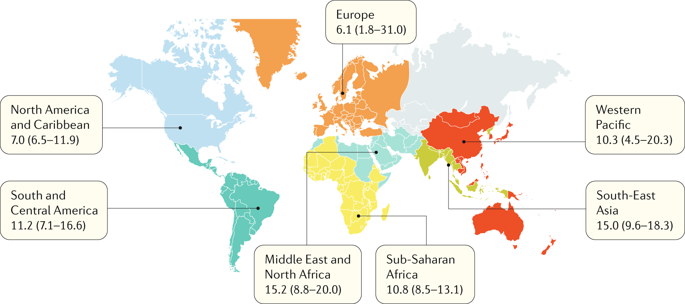当前位置:
X-MOL 学术
›
Nat. Rev. Dis. Primers
›
论文详情
Our official English website, www.x-mol.net, welcomes your
feedback! (Note: you will need to create a separate account there.)
Gestational diabetes mellitus.
Nature Reviews Disease Primers ( IF 76.9 ) Pub Date : 2019-07-11 , DOI: 10.1038/s41572-019-0098-8 H David McIntyre 1 , Patrick Catalano 2 , Cuilin Zhang 3 , Gernot Desoye 4 , Elisabeth R Mathiesen 5 , Peter Damm 6
Nature Reviews Disease Primers ( IF 76.9 ) Pub Date : 2019-07-11 , DOI: 10.1038/s41572-019-0098-8 H David McIntyre 1 , Patrick Catalano 2 , Cuilin Zhang 3 , Gernot Desoye 4 , Elisabeth R Mathiesen 5 , Peter Damm 6
Affiliation

|
Hyperglycaemia that develops during pregnancy and resolves after birth has been recognized for over 50 years, but uniform worldwide consensus is lacking about threshold hyperglycaemic levels that merit a diagnosis of 'gestational diabetes mellitus' (GDM) and thus treatment during pregnancy. GDM is currently the most common medical complication of pregnancy, and prevalence of undiagnosed hyperglycaemia and even overt diabetes in young women is increasing. Maternal overweight and obesity, later age at childbearing, previous history of GDM, family history of type 2 diabetes mellitus and ethnicity are major GDM risk factors. Diagnosis is usually performed using an oral glucose tolerance test (OGTT), although a non-fasting, glucose challenge test (GCT) is used in some parts of the world to screen women for those requiring a full OGTT. Dietary modification and increased physical activity are the primary treatments for GDM, but pharmacotherapy, usually insulin, is used when normoglycaemia is not achieved. Oral hypoglycaemic agents, principally metformin and glibenclamide (glyburide), are also used in some countries. Treatment improves immediate pregnancy outcomes, reducing excess fetal growth and adiposity and pregnancy-related hypertensive disorders. GDM increases the risk of long-term complications, including obesity, impaired glucose metabolism and cardiovascular disease, in both the mother and infant. Optimal management of mother and infant during long-term follow-up remains challenging, with very limited implementation of preventive strategies in most parts of the world.
中文翻译:

妊娠期糖尿病。
妊娠期间发生的高血糖症,以及出生后消退的高血糖症已有50多年的历史了,但在全球范围内,关于血糖阈值水平尚不足以诊断为“妊娠糖尿病”(GDM)并因此在妊娠期间进行治疗的共识尚缺乏共识。GDM是目前最常见的妊娠医学并发症,年轻女性中未确诊的高血糖症甚至明显的糖尿病的患病率正在上升。孕妇超重和肥胖,生育年龄晚,GDM既往史,2型糖尿病家族史和种族是GDM的主要危险因素。诊断通常使用口服葡萄糖耐量测试(OGTT)进行,尽管世界上某些地区使用了非禁食,葡萄糖激发试验(GCT)来筛选需要完全OGTT的女性。饮食调节和增加体育锻炼是GDM的主要治疗方法,但是当未达到正常血糖时,应使用药物治疗,通常是胰岛素。口服降血糖药,主要是二甲双胍和格列本脲(格列本脲),也在一些国家使用。治疗可改善立即妊娠结局,减少过多的胎儿生长以及肥胖和与妊娠有关的高血压疾病。GDM会增加母亲和婴儿长期并发症的风险,包括肥胖,葡萄糖代谢受损和心血管疾病。在世界上大多数地方,预防策略的实施非常有限,因此在长期随访期间对母婴进行最佳管理仍然具有挑战性。当血糖未达到正常水平时,通常使用胰岛素。口服降血糖药,主要是二甲双胍和格列本脲(格列本脲),也在一些国家使用。治疗可改善立即妊娠结局,减少过多的胎儿生长以及肥胖和与妊娠有关的高血压疾病。GDM会增加母亲和婴儿长期并发症的风险,包括肥胖,葡萄糖代谢受损和心血管疾病。在世界上大多数地方,预防策略的实施非常有限,因此在长期随访期间对母婴进行最佳管理仍然具有挑战性。当血糖未达到正常水平时,通常使用胰岛素。口服降血糖药,主要是二甲双胍和格列本脲(格列本脲),也在一些国家使用。治疗可改善立即妊娠结局,减少过多的胎儿生长以及肥胖和与妊娠有关的高血压疾病。GDM会增加母亲和婴儿长期并发症的风险,包括肥胖,葡萄糖代谢受损和心血管疾病。在世界上大多数地方,预防策略的实施非常有限,因此在长期随访期间对母婴进行最佳管理仍然具有挑战性。治疗可改善立即妊娠结局,减少过多的胎儿生长以及肥胖和与妊娠有关的高血压疾病。GDM会增加母亲和婴儿长期并发症的风险,包括肥胖,葡萄糖代谢受损和心血管疾病。在世界上大多数地方,预防策略的实施非常有限,因此在长期随访期间对母婴进行最佳管理仍然具有挑战性。治疗可改善立即妊娠结局,减少过多的胎儿生长以及肥胖和与妊娠有关的高血压疾病。GDM会增加母亲和婴儿长期并发症的风险,包括肥胖,葡萄糖代谢受损和心血管疾病。在世界上大多数地方,预防策略的实施非常有限,因此在长期随访期间对母婴进行最佳管理仍然具有挑战性。
更新日期:2019-11-18
中文翻译:

妊娠期糖尿病。
妊娠期间发生的高血糖症,以及出生后消退的高血糖症已有50多年的历史了,但在全球范围内,关于血糖阈值水平尚不足以诊断为“妊娠糖尿病”(GDM)并因此在妊娠期间进行治疗的共识尚缺乏共识。GDM是目前最常见的妊娠医学并发症,年轻女性中未确诊的高血糖症甚至明显的糖尿病的患病率正在上升。孕妇超重和肥胖,生育年龄晚,GDM既往史,2型糖尿病家族史和种族是GDM的主要危险因素。诊断通常使用口服葡萄糖耐量测试(OGTT)进行,尽管世界上某些地区使用了非禁食,葡萄糖激发试验(GCT)来筛选需要完全OGTT的女性。饮食调节和增加体育锻炼是GDM的主要治疗方法,但是当未达到正常血糖时,应使用药物治疗,通常是胰岛素。口服降血糖药,主要是二甲双胍和格列本脲(格列本脲),也在一些国家使用。治疗可改善立即妊娠结局,减少过多的胎儿生长以及肥胖和与妊娠有关的高血压疾病。GDM会增加母亲和婴儿长期并发症的风险,包括肥胖,葡萄糖代谢受损和心血管疾病。在世界上大多数地方,预防策略的实施非常有限,因此在长期随访期间对母婴进行最佳管理仍然具有挑战性。当血糖未达到正常水平时,通常使用胰岛素。口服降血糖药,主要是二甲双胍和格列本脲(格列本脲),也在一些国家使用。治疗可改善立即妊娠结局,减少过多的胎儿生长以及肥胖和与妊娠有关的高血压疾病。GDM会增加母亲和婴儿长期并发症的风险,包括肥胖,葡萄糖代谢受损和心血管疾病。在世界上大多数地方,预防策略的实施非常有限,因此在长期随访期间对母婴进行最佳管理仍然具有挑战性。当血糖未达到正常水平时,通常使用胰岛素。口服降血糖药,主要是二甲双胍和格列本脲(格列本脲),也在一些国家使用。治疗可改善立即妊娠结局,减少过多的胎儿生长以及肥胖和与妊娠有关的高血压疾病。GDM会增加母亲和婴儿长期并发症的风险,包括肥胖,葡萄糖代谢受损和心血管疾病。在世界上大多数地方,预防策略的实施非常有限,因此在长期随访期间对母婴进行最佳管理仍然具有挑战性。治疗可改善立即妊娠结局,减少过多的胎儿生长以及肥胖和与妊娠有关的高血压疾病。GDM会增加母亲和婴儿长期并发症的风险,包括肥胖,葡萄糖代谢受损和心血管疾病。在世界上大多数地方,预防策略的实施非常有限,因此在长期随访期间对母婴进行最佳管理仍然具有挑战性。治疗可改善立即妊娠结局,减少过多的胎儿生长以及肥胖和与妊娠有关的高血压疾病。GDM会增加母亲和婴儿长期并发症的风险,包括肥胖,葡萄糖代谢受损和心血管疾病。在世界上大多数地方,预防策略的实施非常有限,因此在长期随访期间对母婴进行最佳管理仍然具有挑战性。











































 京公网安备 11010802027423号
京公网安备 11010802027423号